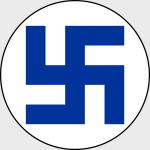Hobby Master HG3013 Finnish Kliment Voroshilov KV-1E Heavy Tank - 3rd Company, Finnish 1st Tank Brigade, Karelian Isthmus, July 1944 (1:72 Scale)
"By powerful artillery fire, air strikes, and a wave of attacking tanks, we're supposed to swiftly crush the enemy."
- Marshal Georgi K. Zhukov
 Design on the KV-1 heavy tank began in 1938, with the intention that it should be the successor to the T-35 heavy tank. The first models of the KV-1 were field-tested during the Red Army's disastrous 1940 campaign in Finland. Despite the military setback, the KV-1 set the standard for Soviet tank design for several years to come, regularly used to spearhead breakthroughs or accompany infantry on the assault. While it was certainly a formidable vehicle, the KV-1 was not particularly mobile, routinely suffering from a number of automotive problems. It was also uparmored progressively without any concomittant changes made to the power plant, which resulted in a poor power-to-weight ratio and continual degradation in performance. Nevertheless, many historians view the KV series as an important achievement for the Russian military-industrial complex because it paved the way for more successful designs, including the "Josef Stalin" tanks.
Design on the KV-1 heavy tank began in 1938, with the intention that it should be the successor to the T-35 heavy tank. The first models of the KV-1 were field-tested during the Red Army's disastrous 1940 campaign in Finland. Despite the military setback, the KV-1 set the standard for Soviet tank design for several years to come, regularly used to spearhead breakthroughs or accompany infantry on the assault. While it was certainly a formidable vehicle, the KV-1 was not particularly mobile, routinely suffering from a number of automotive problems. It was also uparmored progressively without any concomittant changes made to the power plant, which resulted in a poor power-to-weight ratio and continual degradation in performance. Nevertheless, many historians view the KV series as an important achievement for the Russian military-industrial complex because it paved the way for more successful designs, including the "Josef Stalin" tanks.
Pictured here is a 1:72 scale Finnish Kliment Voroshilov KV-1E Heavy Tank that was attached to the 3rd Company, Finnish 1st Tank Brigade, then deployed to the Karelian Isthmus, during July 1944.
Sold Out!
Dimensions:
Length: 3-1/2-inches
Width: 1-1/2-inches
Release Date: October 2015
Historical Account: "The Continuation War" - The Continuation War (Finnish: jatkosota; Swedish: fortsattningskriget; June 25th, 1941 - September 19th, 1944) consisted of hostilities between Finland and the Soviet Union from 1941 to 1944. The Continuation War began shortly after the end of the Winter War, which also was fought between Finland and the Soviet Union. In the Soviet Union, the war was considered part of the Great Patriotic War. Germany regarded its operations in the region as part of its overall war efforts on the Eastern Front, and it provided Finland with critical material support and military cooperation.
Acts of war between the Soviet Union and Finland recommenced on June 22nd, 1941, the day Germany launched its invasion of the Soviet Union, with covert Finnish operations. Open warfare began with a Soviet air offensive on June 25th. Subsequent Finnish operations undid its post-Winter War concessions to the Soviet Union on the Karelian Isthmus and Ladoga Karelia, and captured East Karelia by September 1941. On the Karelian Isthmus, the Finns halted their offensive 30 km from Leningrad, at the pre-World War II border between the Soviet Union and Finland. Finnish forces did not participate in the siege of Leningrad directly, holding their pre-World War II territory on the Karelian Isthmus for two and a half years instead. In 1944, Soviet air forces conducted air raids on Helsinki and other major Finnish cities. Eventually, in mid-1944, the Soviet strategic offensive drove the Finns from most of the territories they had gained during the war, but the Finnish Army later brought the offensive to a standstill in July 1944. A ceasefire ended hostilities on September 5th and was followed by the Moscow Armistice on September 19th. The 1947 Paris peace treaty concluded the war formally. Finland ceded Petsamo Province to the Soviets, leased Porkkala peninsula to them, and paid reparations, while retaining its independence.


